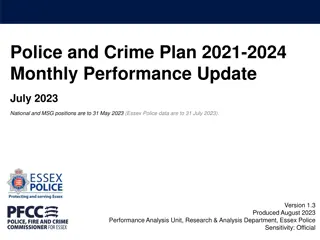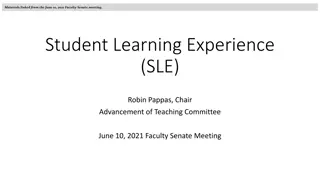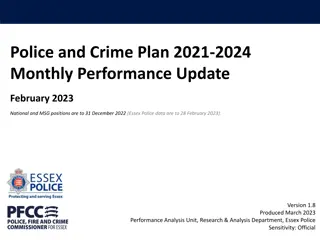December 2020 Essex Local Delivery Pilot Monthly Evaluation Update
The December 2020 update of the Essex Local Delivery Pilot's monthly evaluation includes actions from the previous month, process evaluation details, population information, test and learn strategies, learning and development insights, recommendations, and further information. Key evaluation activities for October are highlighted, along with progress on qualitative analysis, workshop participation, interviews, data collection, and more.
Download Presentation

Please find below an Image/Link to download the presentation.
The content on the website is provided AS IS for your information and personal use only. It may not be sold, licensed, or shared on other websites without obtaining consent from the author. Download presentation by click this link. If you encounter any issues during the download, it is possible that the publisher has removed the file from their server.
E N D
Presentation Transcript
Essex Local Delivery Pilot: Monthly evaluation update December 2020 The University of Essex Evaluation Consortium
Contents 1. Actions from last time 2. Process evaluation and whole systems 3. Population 4. Test and Learn 5. Learning and Development 6. Recommendations and Actions 7. Further information
October Actions LDP team (core, delivery) Action Status Logic model for system level intervention/activities, e.g. ABCD, community Hub, Active environments- Tendring- ideally 1 month prior to start Confirm when and how follow-up data can be collected from Essex Assembly None received as yet Awaiting details 15thDec? Confirm date for workshop on reflections on process learning report Any more recommendations for system level interviews for hard- wiring, active environment, social movements and unusual suspects research questions by 16thNovember Ongoing Discuss approach to mapping the system and confirm with evaluation by 23rdNovember Complete mapping of LDP activities/investments to LDP on a page Awaiting details Ongoing
Key evaluation activities for October Activity Activity Status Status PEM evaluation commence and finalise remaining components Elements started State of Life launch Survey is live Workshop for Process Learning report Core team leading Ongoing Conduct and analyse interviews with stakeholder in the whole system Qualitative analysis for whole systems research Ongoing Ongoing Further closer look work about embedding evaluation Collect follow-up data from Essex Assembly Incomplete Continue with Test and Learn data collection Ongoing
2. Process evaluation and whole systems
Whole Systems evaluation 1. Qualitative analysis of interviews for four whole systems research questions ongoing 2. Evaluation of various interventions in discussion stages (e.g., Additional Heritage grant, Pedal Power Essex, ABCD) 3. PEM a) All elements of evaluation are finalised and live (or ready for start of workstreams yet to start delivery) 4. Whole systems survey for core team is live
Core team whole systems survey (very preliminary results) How important each feature is perceived to be for the Essex LDP whole systems work (5 = Extremely important) How successful the Essex LDP has been in implementing each feature (5 = Extremely successful
Whole system recommendations Logic models should be completed for all system level programmes/initiatives/interventions The LDP team should produce a map of the system
State of Life/Reference data State of Life/Reference data Over 600 responses since 19th November (over 3000 since April) Majority from postcodes in Essex Over 250 residents of Basildon, Colchester and Tendring (33% in IMDs 1-4) in November Data collection will stop ~14th December
Preliminary finding Preliminary finding A trend for individuals in more deprived areas to individuals in more deprived areas to spend more time sitting compared to spend more time sitting compared to individuals in less deprived areas. individuals in less deprived areas. A trend for Lines show deprivation quintiles (i.e., line 1 represents Lines show deprivation quintiles (i.e., line 1 represents IMDs 1 and 2). IMDs 1 and 2).
Trend in a similar direction for number of days of Trend in a similar direction for number of days of moderate physical activity per week but moderate physical activity per week but decrease appears greater in those in higher decrease appears greater in those in higher deprivation. deprivation. Lines show deprivation quintiles (i.e., line 1 represents Lines show deprivation quintiles (i.e., line 1 represents IMDs 1 and 2). IMDs 1 and 2).
The pattern is less clear for muscle The pattern is less clear for muscle strengthening activity. strengthening activity. Lines show deprivation quintiles (i.e., line 1 represents Lines show deprivation quintiles (i.e., line 1 represents IMDs 1 and 2). IMDs 1 and 2).
Population Recommendations Population Recommendations LDP should continue to target areas of high deprivation (IMDs 1-4) to tackle physical (in)activity and reduce inequalities LDP team should consider whether reducing sitting time is an explicit outcome of interest
Providers report that Providers report that microgrant investments are making a difference investments are making a difference microgrant The improvement to mental wellbeing has been immediate and lasting, with some residents getting their first exercise in eight months as a direct result of this intervention. Better balance and coordination noticed by staff. One of the users, who is blind and has sensory issues with being touched, and has been unable to attend his twice-weekly trampoline sessions since March, appeared to become somewhat overwhelmed with happiness as soon as his body touched the trampoline. The children have really enjoyed the sessions and the improvements which have been made can be seen in their other PE lessons and other areas of learning. We have seen an improvement in behaviour management.
Higher level investments are Higher level investments are benefitting from collaborative benefitting from collaborative working working 69% of interventions have been develop with organisations working in partnerships On average, the lead organisation has worked alongside 4 other organisations 23% of partnerships are newly formed Types of partnerships typically vary from working together as a formal team through to more informal arrangements but with common programme goals Partnerships are typically rated as very- extremely effective
The benefits of collaboration The benefits of collaboration Partnership working has been key to all aspects of planning and delivery for [intervention]. Genuine collaboration and coproduction is essential to make an impact on the system. There are different perspectives and cultures but we have formed a strong and trusting relationship. In this last week, we have overcome some significant challenges together. I had already aligned one of my senior staff to a [intervention], but now have plans for another one of my senior team to work hand in hand with the [partner organisation] lead on a day to day basis to increase our joint effort and capacity and galvanise an even more integrated approach.
Test & Learn Recommendations Test & Learn Recommendations Essex LDP should continue to facilitate opportunities for organisations to come together to share ideas and best practice, with a view to forming partnerships to tackle physical inactivity.
5. Learning and Development
Embedding evaluation remains an issue Co-production of evaluation plans is time-consuming Receiving timely provider and participant responses remains a challenge with less than 50% of participants providing a true baseline How long participants had been involved with project/organisation when they completed the PWA About to start Less than 1 week 1-4 weeks 1-3 months 4-6 months 7-12 months 1-2 years More than 2 years Prefer not to say
Evaluation reflections/learnings Evaluation needs to be embedded early in process of developing interventions with clear governance process Important for interventions to specify key outcomes, which are well defined Reflective logs appear well accepted (especially in PEM) and could be used more widely Key learnings from interventions are shaping future developments (e.g., Street Tag)
Learning and development recommendations Evaluation should continue to be embedded and intervention providers encouraged and supported to provide data in a timely manner
6. Recommendations and Actions
Recommendations Logic models should be completed for all system level programmes/initiatives/interventions The LDP team should produce a map of the system LDP should continue to target areas of high deprivation (IMDs 1-4) to tackle physical (in)activity and reduce inequalities LDP team should consider whether reducing sitting time is an explicit outcome of interest Essex LDP should continue to facilitate opportunities for organisations to come together to share ideas and best practice, with a view to forming partnerships to tackle physical inactivity. Evaluation should continue to be embedded and intervention providers encouraged and supported to provide data in a timely manner
Actions LDP teams 1. Advise on priorities for any bespoke evaluations by 15th January 2. Logic models for system level intervention/activities, e.g. ABCD, community Hub, Active environments- Tendring- ideally 1 month prior to start 3. Confirm when and how follow-up data can be collected from Essex Assembly by 19th December 4. Any more recommendations for system level interviews for hard- wiring, active environment, social movements and unusual suspects research questions by 19th December 5. Discuss approach to mapping the system and confirm with evaluation team by 19th December 6. Complete mapping of LDP activities/investments to LDP on a page
Key evaluation activities for next month 1. Analyse State of Life (Nov/Dec) data 2. Conduct and analyse interviews with stakeholder in the whole system 3. Qualitative analysis for whole system research questions 4. Further closer look work about embedding evaluation 5. Collect and analyse follow-up data from Essex Assembly 6. Continue with Test and Learn data collection and analysis 7. Draft annual report
7. Further information If you require any further information relating to the content of this report, or have any particular questions, please contact us using the details below: Email: essexldpevaluation@essex.ac.uk























